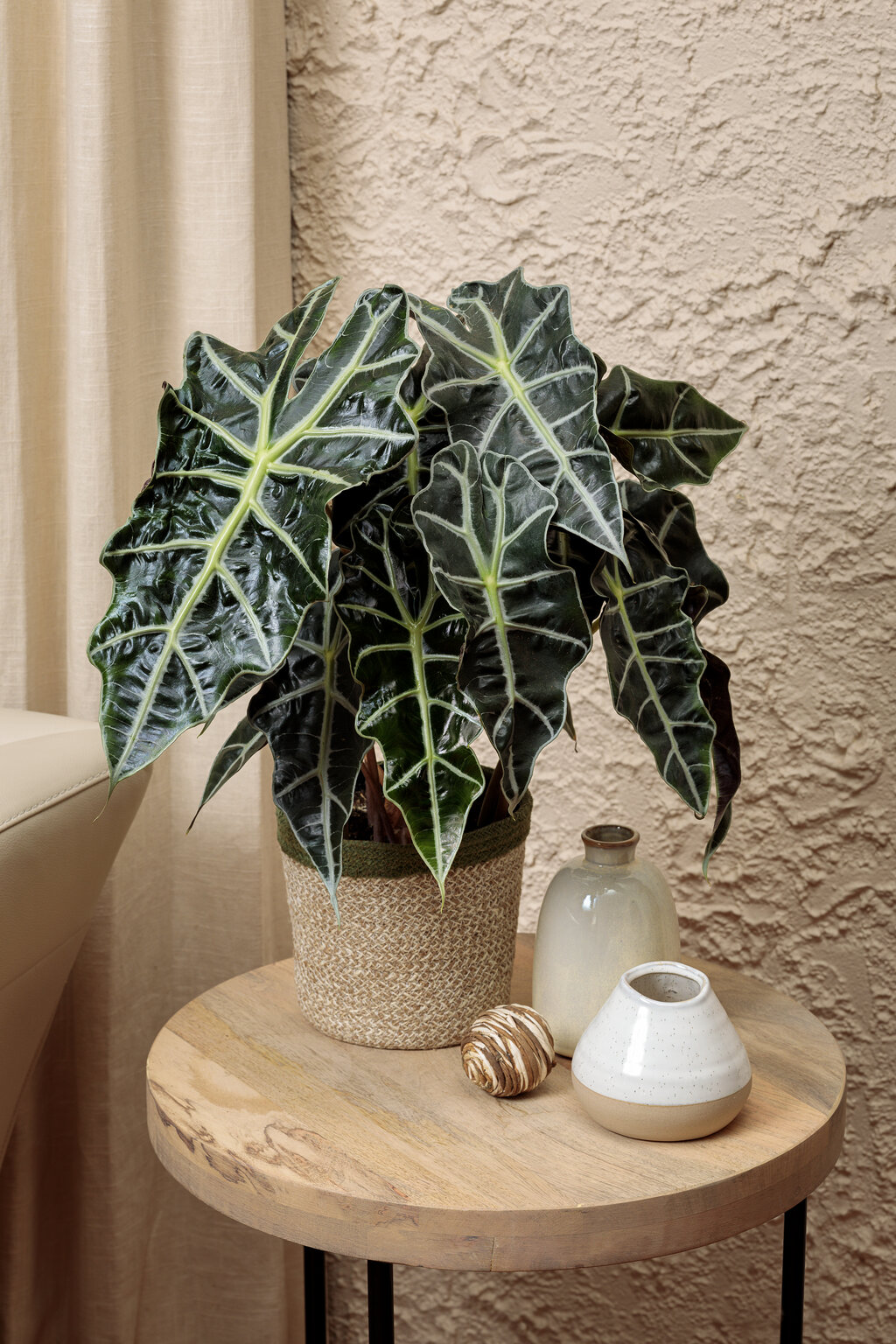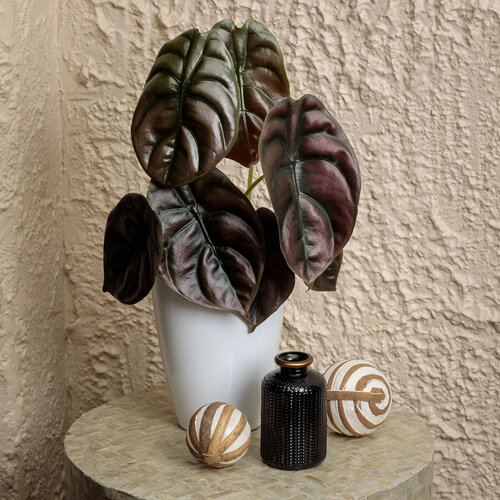Alocasia - The Ultimate Growing Guide from Proven Winners®
Grow this exotic-looking tropical plant with eye-catching foliage indoors as a houseplant or outdoors during warmer weather.
 Check here to see if your Local Garden Center or The Home Depot® is carrying leafjoy™.
Check here to see if your Local Garden Center or The Home Depot® is carrying leafjoy™.
Alocasia is an ornamental plant grown for the large heart- or arrow-shaped foliage that resembles elephant ears, hence the common name. Also known as African mask plant, alocasia is most commonly grown indoors as a houseplant, though it can also be grown outside during warmer months in beds, borders and containers. Alocasia varieties occur in many different leaf colors, sizes and shapes.
Native to tropical regions of the South Pacific, Asia and eastern Australia, these captivating tropical plants can reach 10 feet tall, though will remain smaller as an indoor houseplant. Alocasia grows from tubers or rhizomes and goes dormant in winter. Though alocasia can be somewhat finicky, it will thrive indoors when given the right growing conditions.
ALOCASIA CARE & PLANTING
How to plant: Plants prefer to be slightly pot bound. Wait to transplant until roots are visible in the drainage hole at the bottom of the pot. Repot in spring when plants begin putting on new growth.
- Choose a pot that is 1 to 2 inches larger in diameter and slightly deeper than the previous pot.
- Remove the plant from its current pot and check for any signs of root rot. Tease out roots if compacted and cut out any visibly rotted or damaged sections. Divide rhizomes as needed and plant extra rhizomes in separate containers.
- Place fresh potting soil in the bottom of the new pot.
- Set rhizomes in the pot at the same level as they were in the previous container.
- Add fresh potting medium around the sides of the root ball up to the base of the stem.
- Press down soil gently to remove air pockets and water well. Avoid fertilizing for the next 3 months.
Light: Alocasia plants grow natively under a dense rainforest canopy with bright shade or dappled sunlight. Place indoor plants in a location that receives bright indirect light such as a window with eastern or western exposure. Outdoors, grow in a spot that receives open shade. Avoid direct sun exposure to prevent leaf scorch. Alocasia light needs can be supplemented with artificial grow lights.
Temperature: Alocasia does best in temperatures between 60 to 85 degrees F. Don’t allow temperatures to drop below 60 degrees F. Keep plants away from cold drafts and heating vents, and avoid any sudden change in temperature.
Humidity: Alocasia is accustomed to high humidity in its native habitat. Plants can be grown in a bathroom, kitchen or other humid environments. To increase the humidity around the plant, use a room humidifier or place plants on a pebble tray filled with water. To prevent root rot, don’t allow the bottom of the pot to sit in water.
Soil: Grow in a well-draining potting mix that retains moisture. Use a potting mix specially formulated for alocasia, or a high-quality all-purpose potting mix with additional amendments to improve drainage such as orchid bark, perlite, peat moss, vermiculite or coco coir.
Watering: Keep alocasia soil evenly moist. Dry or soggy soil can cause plant stress. Water when the top 2 to 3 inches of the soil is dry to the touch. Allow water to flow into the pot until you see liquid coming out of the drainage hole. As plants are susceptible to root rot, discard any standing water in the saucer beneath the pot. Reduce alocasia watering in fall and winter when plants go dormant, keeping the soil slightly moist. Plants may be sensitive to tap water that contains excess minerals or chlorine. If plants develop spots on the leaves, switch to distilled water or allow tap water to stand for 24 hours before using.
Fertilizing: Feed once or twice a month during the growing season with a liquid fertilizer formulated for houseplants diluted to half strength, or use a slow-release fertilizer.
Pruning: Trim off any yellow, damaged or diseased leaves as needed. Wear gloves when pruning alocasia to avoid possible skin irritation.
Additional care: Alocasia plants will likely go dormant during winter months. Keep plants in a warm place and cease fertilizing. Reduce watering but don’t allow the container to completely dry out. Resume normal feeding and watering when plants begin to show new growth in spring.
TRY THESE PROVEN WINNERS® LEAFJOY™ VARIETIES
Here are some attractive alocasia varieties to augment your indoor decor:
 Mythic™ Red Secret Jewel Alocasia (Alocasia cuprea) produces slightly puckered leaves that emerge coppery-green, darkening to deep maroon. The foliage has dark, nearly black veining and a bright, metallic-like sheen. Plants remain smaller, 12 to 18 inches tall at maturity. |
 Mythic™ Dragon Scale Jewel Alocasia (Alocasia baginda) produces arrow-shaped light green leaves with darker green veining. The mottled foliage gets darker with age and has a shiny, silvery sheen. Plants can reach up to 3 feet tall when grown in ideal conditions, though will stay smaller as a houseplant. |
 Mythic™ Frydek Elephant Ears (Alocasia hybrid) has velvety deep green leaves accentuated with bold, creamy-white veining. The large heart-shaped foliage makes a bold statement in any style room decor. Plants can reach up to 3 feet tall, but will stay smaller as an indoor houseplant. |
 Mythic™ Silver Dragon Jewel Alocasia (Alocasia baginda) is a silvery-grey version of Dragon Scale, with a luminous leaf surface and intricate dark green veining. Use this striking variety as a bold accent in a living room or office. Plants can reach 12 to 24 inches tall. |
Mythic™ Longiloba (Alocasia longiloba) showcases elongated, deep green leaves with striking white to pale green veining. This variety thrives in medium indirect light, preferring high humidity and consistent moisture. May reach up to 36" tall in ideal conditions. |
 Mythic™ Lauterbachiana Purple Sword Elephant Ear (Alocasia lauterbachiana) features long, narrow leaves with wavy edges, deep green on top and purple underneath. This easy-to-grow variety thrives in medium indirect light and high humidity. As a houseplant, it can reach up to 24 inches tall. |
ALOCASIA FAQ’s
Is Alocasia good for an indoor plant?
Alocasia makes a good houseplant when given the right growing conditions. This attractive plant lends an exotic tropical touch to indoor home or office decor.
How do you take care of an Alocasia plant?
Alocasia prefers consistent growing conditions and may become stressed with sudden changes to its environment. Stressed plants can be more prone to spider mites and other pests or diseases.
How poisonous is Alocasia?
Alocasia contains calcium oxalate crystals, which are mildly to severely toxic for animals and humans if any part of the plant is ingested. Keep plants out of reach of pets and small children, and wear gloves when directly handling plants to prevent possible skin irritation.
Why do Alocasia leaves turn yellow?
There are many reasons why alocasia leaves turn yellow. The most common cause is overwatering, though other causes include insufficient light, low humidity, lack of warmth, poor soil or nutritional deficiency. Older leaves will naturally turn yellow and die as new leaves emerge.
Should I mist my Alocasia?
Foliage can be misted once or twice a week to help raise humidity levels and keep leaves clean. Too much misting may result in fungal disease. Spray in the morning to allow plants to dry out during the day.
What does an overwatered Alocasia look like?
Too much water can cause leaves to droop, develop brown spots, turn yellow, or become soft and mushy. Other signs of overwatering include mold, root rot, pests such as soil gnats, mildew or fungus on leaves or in the soil.
HOW TO USE ALOCASIA IN YOUR HOME OR OFFICE
There are many ways to display alocasia in your home, office or outdoors. Here are some ideas:
- Use a larger variety as a floor specimen and display in an office lobby, living room or other spacious area for an arresting focal point.
- Group smaller alocasia specimens with other houseplants with similar needs and display on a large dining room or office boardroom table for year-round living color.
- Place a multi-tiered plant stand in a living room or bedroom and showcase several specimens of alocasia along with some of your other favorite houseplants.
- Adorn an office desk with a smaller variety planted in a colorful pot to cheer up your work environment. See more space-saving plants for desks and tabletops.
- Plant a larger variety in a shady bed or border during warmer months alongside colorful flowering annuals such as impatiens, begonias and wishbone flower.
- Adorn a hallway table with a smaller specimen and accessories such as a colorful table runner and candles.
- Place a favorite alocasia variety in a macrame hanger and display in a smaller room where space is at a premium.
- Decorate a shady patio, deck or other outdoor living area with a colorful container planted with alocasia and annual flowers for an exotic touch.
- Place an alocasia plant in a decorative pot and display in a room with higher humidity such as a bathroom or kitchen. See more plants for humid spaces.
Get more ideas for decorating with plants.
ALOCASIA COMPANIONS
For a colorful indoor display, include these other houseplants that thrive in similar growing conditions:
- Mysteria™ monstera
- Beautifall™ N’ Joy pothos
- Color Full™ Sanderiana pinstripe calathea
- Living Lace™ Victoria Japanese bird’s nest fern
- Lily Pads™ umbrella fig tree
- Prismacolor™ Imperial Green philodendron
- Maggy Queen of Hearts homalomena





